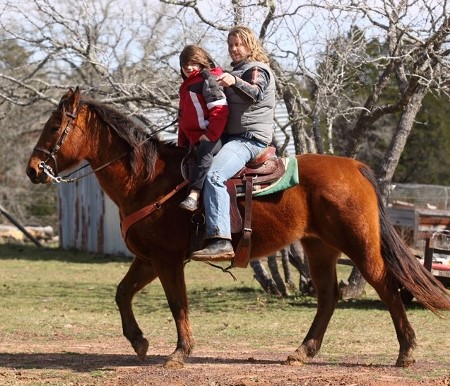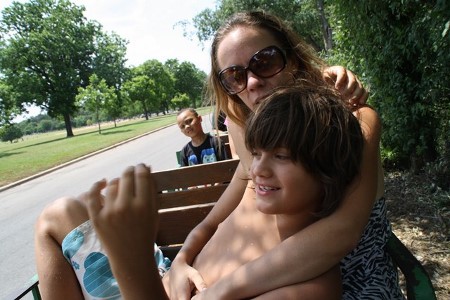Kinetic learning with the Horse Boy
/Alt Ed Austin is honored to share this moving story from guest contributor Jenny Lockwood. Jenny is an educational psychologist and alternative educator who works with a child known worldwide as The Horse Boy and with other remarkable children and their families at Horse Boy World in Elgin, Texas.

In April 2004 Rowan Isaacson was diagnosed with autism. At the age of two and a half he suffered from neurological tantrums that could last for hours and that his parents were powerless to stop. He could repeat long passages of text from his favorite books and movies but was unable to tell his parents he was hungry, thirsty, or tired. He was incontinent and unable to make friends. At age three his speech therapist “gave up” on him and told his parents that he would never use expressive language.
That was almost ten years ago. Rowan is 12 now, and earlier today he told me that he wanted to open his own zoo to provide “a forever home for animals that are abused and neglected.” He is ahead academically, has friends of all ages, and wants to help other special (his word) kids like himself learn to talk, read, and write. So what changed?
When he was almost four years old, Rowan ran away from his father, Rupert, into their neighbor’s horse pasture and threw himself down on the ground in front of a horse called Betsy. His Dad, a lifelong horse person, was terrified that his precious son was about to be trodden on and certainly did not expect Betsy to lower her head and begin to sniff and breathe on Rowan whilst he giggled in delight.
Up until this moment Rupert had been keeping Rowan away from horses, afraid that he would get hurt. But now both his son and the horse had given him a clear sign. He approached his neighbor, Stafford. Instead of worrying about liability, Stafford, a true southern gentleman, gave Rupert the key to his barn and said, “Have at it.”

From that moment onward, Rowan and Rupert lived in the saddle together. And the more they rode, the more Rowan began to talk. You can learn more about this story and the family’s subsequent trip to Mongolia in the book and film The Horse Boy.
Around the same time that Rowan met Betsy, his parents made the difficult decision to pull him out of school. He had been stuck all day in a windowless classroom with unmotivated teachers who kept the television turned up loud to drawn out the noise of the kids. Rupert began to homeschool Rowan, and Betsy was a huge part of that. They did a lot of learning, from letters and numbers to reading and writing to basic arithmetic and fractions, up there in the saddle together. When Rowan was on the horse, he seemed to be in an ideal position to soak up new information and make it his own.
Over the years we have discovered that the reason this works is the movement that the horse provides. Children with autism are often kinetic learners, meaning that they need to move in order to be able to learn. Force them to sit at a desk, and all they will learn is how to sit at a desk. Allow their bodies to move, and their brains will be free to receive and retain information.
I have been Rowan’s main teacher for about five years now. We discovered how important movement was to his learning after I had been working with him for about a year. Back then, we still did all his academics inside at a desk but allowed him frequent breaks to go outside and bounce on the trampoline or ride. We always supplemented what he was doing on the horse, of course, but when it came down to “serious” academics, we went inside.
Then one day I decided it was time to start his multiplication tables. He flew through his 0 and 1 times table, but when we got to the 2 times table he began to struggle. The more he struggled, the more he rocked in his chair, so that he eventually fell off and the chair fell on top of him. That seemed a good time to take a break!
So outside we went to the trampoline to blow off some steam. Then I had a brainwave: Why not learn the multiplication tables outside whilst bouncing and having fun? He loved the trampoline, so he was motivated to be on it . . . maybe the movement would help him pay attention?
Little did I know how true that would turn out to be.

By the end of a 30-minute bounce session, he had already mastered the 2 and 3 times tables. By the end of the week, we had done all 12 and were moving on to division (and I had lost more than a few pounds to boot). It was so successful, in fact, that from that day onward we abandoned any thought of trying to teach Rowan at a desk and instead created a whole curriculum for him based around movement. He learned angles through chase games and equations through treasure hunts. We discovered how to calculate the relationships among speed, distance, and time on bike rides and did force, mass, and acceleration through wheelbarrow rides.
What’s more, we began to try the same techniques with other children—some on the autism spectrum, some not—and it worked just as well, as long as the games and activities were adapted to those kids’ interests and passions and we incorporated movement, movement, and yet more movement.

We now work directly with hundreds of children on the autism spectrum each year and indirectly with thousands through the trainings we provide for equine professionals, teachers, and parents. To find out more about our work, please visit our website or contact me at jenny@horseboyworld.com.
Jenny Lockwood









